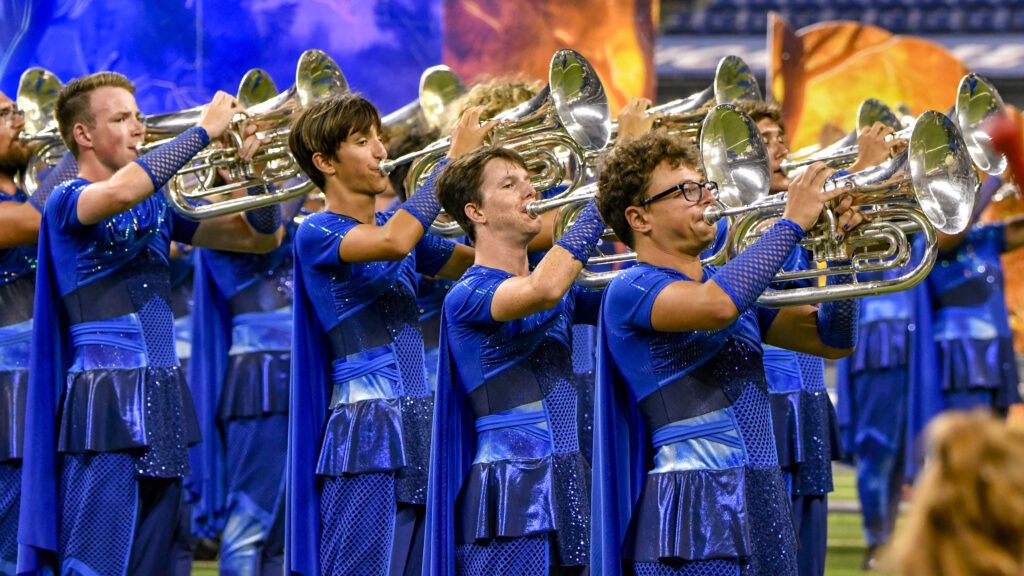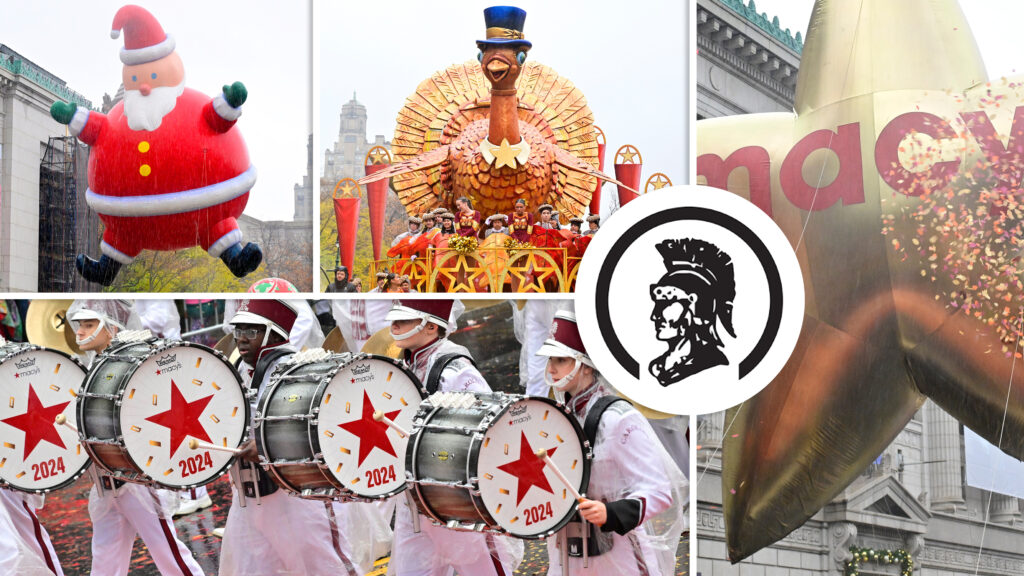Stories of “star-crossed lovers” have been part of world literature for centuries, dating back to the days of Shakespearan theatre.
It’s somewhat of a simple concept, really. Two individuals, who often come from different worlds, fall in love, but due to an external problem outside of their control, cannot ultimately be with one another.
“All of those stories end with death or separation or both,” said Russ Gavin, Blue Stars’ corps director at the time. “We’ve all had our hearts broken, and some of the finest tales that have ever been told are focused on that theme.”
As such, Blue Stars’ 2017 production, “Star Crossed,” was a tale as old as time.

In 2017, Blue Stars explored the concept of the “star-crossed lovers” through the lens of three popular stories from three unique eras — “Romeo and Juliet,” “The Great Gatsby” and “Moulin Rouge.”
Utilizing music, colors, characters and quotations distinctly tied to each story in three separate movements, Blue Stars painted an ever-familiar picture on football fields across the 2017 Drum Corps International Tour.
“We’re all telling the same stories over and over again; the great philosophers and writers always emphasize that,” Gavin said. “The story of the star-crossed lovers is so deeply entrenched in literature and film, remembering that the star-crossed lover doesn’t work out. What we’re talking about is not an alpha-to-omega story, it’s just visiting and reminding ourselves of these moments of deep love and heartbreak.”
2017 Blue Stars | “Star Crossed”
10th Place, 88.925
Blue Stars’ uniforms in 2017 carried over similar characteristics from an iteration debuted in 2016.
The uniform featured navy blue pants with dark gray backs and a half-sleeveless jacket top with a navy blue base and white-to-gray accent which faded from members’ left shoulder to right waist.
Chest, right-sleeve and leg-cape fabric was designed to look like yellow parchment, and it displayed cursive sentences from the novels represented in the corps’ production. The uniform was topped by a white and gray shako with a tall, navy blue plume.
As for color guard members, each donned three different costumes as the show progressed, to match the show’s three referenced stories — Shakespearean-era clothing for “Romeo & Juliet,” attire of the roaring ‘20s for “The Great Gatsby,” and more modern outfits with red accents for “Moulin Rouge.”

The show opened with soft piano music — referenced from Des’Ree’s “Kissing You,” a song prominently featured in the 1996 film adaptation of “Romeo and Juliet” — early narration from “Romeo and Juliet,” and the sound of a quill pen scratching out, presumably, the same stage-setting narrated words:
“Two households in fair Verona… is where we lay our scene. A pair of star-crossed lovers…”
On the word “lovers,” brass members began to enter the field, playing to the back sideline with soft, growing chords, as further narration began to introduce the “Romeo and Juliet” story. All of the above built toward a swelling and emotional opening impact, which featured an impressive increase in pace toward the uptempo introduction of Prokofiev’s sharp “Romeo and Juliet” ballet.
This second portion of the show’s first story brought to life the two characters’ worlds — that is, the warring Montague and Capulet families. An aggressive and, at times, bouncing piece of music, it featured impressive rhythmic articulation from brass members, while giving Blue Stars’ percussion section the opportunity to take multiple center-stage moments, musically speaking.
To eventually round out the production’s opening tale, one last well-known narration echoed:
“For was a story of more woe, than this of Juliet and her Romeo.”
Following smooth and ear-catching transitional sound effects, Blue Stars’ ballad movement then brought “The Great Gatsby” to life, as color guard members changed into an array of cooler colors with early 20th-century flair. The movement largely featured a modern song, Lana del Rey’s “Young and Beautiful,” which had been popularized in the story’s 2013 film adaptation.
This movement wasn’t nearly as long as the corps’ “Romeo and Juliet” retelling, but equally impactful. As it transitioned into focus, Blue Stars played off of the same set of sound effects that had started the show’s first movement, except this time, aptly paired with the clicking sounds of a typewriter, they were the words of F. Scott Fitzgerald’s classic:
“Gatsby looked at Daisy in a way that every young girl wanted to be looked at…”
It was with these words that Blue Stars’ baritones and euphoniums entered, presenting the soft, resonant chords of Lana del Rey’s ballad. Further narration led into a high brass entrance, while front ensemble percussionists matched the music’s tone with light, airy and spacious accents.

As the words of the book’s main female protagonist, Daisy, cascaded across the field, — “I wish I’d done everything on this earth with you…” — a flugelhorn soloist brought forth the song’s main melody, their final note glistening up the scale to make way for a resounding brass impact.
This powerful moment featured Blue Stars’ full brass section forming a condensed block just to the right of the 50-yard-line, moving in choreographed unison before spreading out into an expansive arched form across the field, and ultimately pushing all of their energy into a strong, suspended chord.
Once this chord released, Blue Stars again reminded the audience of the tragic nature of the star-crossed story, and closed the corps’ second retelling on a somber note:
“(Gatsby’s) dream must have seemed so close that he could hardly fail to grasp it. He did not know that it was already behind him…”
Voiced lyrics from Lana del Rey’s song, melded with the “Moulin Rouge”-inspired lyrics of Bob Crewe and Kenny Nolan’s “Lady Marmalade,” marked the transition to an even newer story for Blue Stars’ final movements.
The corps’ “Moulin Rouge” section first mixed shades of “Lady Marmalade,” Eden Ahbez’s “Nature Boy,” and “Diamonds are a Girl’s Best Friend,” in a percussion- and dance-heavy movement that carried the high-energy and fierce nature of the musical.

A grooving passage of battery percussion music, that lined up swimmingly with the lyrics of “Lady Marmalade,” quickly phased into a rapid accelerando, all building to a sharp final percussive impact. Upon this release, the lyrics of “Come What May” — also from “Moulin Rouge” — echoed alongside rising synthesizer and front ensemble chords.
At the apex of this crescendo, a shout of the corps’ mantra, “FCO!” — an acronym standing for “finis coronat opus, which translates in Latin to “the end crowns the work” — billowed from the members on the field, before a powerful “Come What May” brass entrance.
When this emotional moment built to its climactic chord, the corps’ mellophone players stuck out with a brief melodic reference to Prokofiev’s “Romeo and Juliet,” a subtle final nod to arguably the oldest “star-crossed” story ever told.
And finally, as had been a trait of many recent Blue Stars productions, the corps ended on an up-tempo note with high-speed drill matching energetic and driving music, all pushing toward the final shape of a star with a small ‘X’ inside of it — a fitting visual ending to a production littered with creative symbolism.
Back-and-Forth

Blue Stars’ 2017 competitive season was predicated on a neck-and-neck battle for positioning on the World Class scoring leaderboard with Crossmen.
The two met 14 times that season. While Blue Stars scored higher in seven of the first eight, the next three went to Crosmen, but the La Crosse, Wisconsin corps flipped the script back in its favor to earn a Top 10 spot at the DCI World Championships.
In the race between the two corps, the DCI World Championship Finals marked the only event on the 2017 DCI Tour, in which Crossmen and Blue Stars were separated by more than one point, with Blue Stars ahead of their San Antonio, Texas opponent by 1.113 points.
Ultimately, Blue Stars’ competitive stronghold was its visual scores. The corps finished ninth overall in the visual caption, while earning eighth place in the color guard subcaption. Blue Stars also scored ninth in brass and percussion 2.
In finishing 10th overall, Blue Stars earned the corps’ fifth consecutive finalist position and third Top 10 placement since missing out on the Top 12 finalist pool in 2012.





